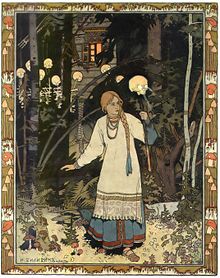Throughout fairy tales, children are often used as the main heroes in many stories for a variety of purposes. According to Maria Tatar, “the child protagonists of fairy tales do battle with dark forces, but, more important, they begin as hostile powers at home,” (Tatar 229). In many fairy tales, children are seen as trickster figures, who use their wits and skills to escape the villain or bad situation.
 In the Russian fairy tale “Vasilisa the Fair,” the main protagonist, Vasilisa, also functions as a trickster type of character. Vasilisa leaves home to get fire from the baba yaga, and when she gets there the baba yaga gives her all kinds of impossible chores to have done each day. Vasilisa is only able to complete the challenges with the help of her magical doll, who does most of the work for her, therefore she tricks the baba yaga into thinking she actually did all the work, when she didn’t. When Vasilisa is finally able to leave with the fire, she returns home and the fire actually ends up burning her step-mother and step-sisters to ashes. Then Vasilisa ends up getting married to the tsar and living happily ever after. Like in other child protagonist fairy tales, Vasilisa faces hardships at home from her step-family, and then she leaves and faces evil, and uses trickery to get away, and then eventually lives happily ever after. Vasilisa’s role as a trickster not only helps her escape the baba yaga, but it also helps her get away from her abusive step-family.
In the Russian fairy tale “Vasilisa the Fair,” the main protagonist, Vasilisa, also functions as a trickster type of character. Vasilisa leaves home to get fire from the baba yaga, and when she gets there the baba yaga gives her all kinds of impossible chores to have done each day. Vasilisa is only able to complete the challenges with the help of her magical doll, who does most of the work for her, therefore she tricks the baba yaga into thinking she actually did all the work, when she didn’t. When Vasilisa is finally able to leave with the fire, she returns home and the fire actually ends up burning her step-mother and step-sisters to ashes. Then Vasilisa ends up getting married to the tsar and living happily ever after. Like in other child protagonist fairy tales, Vasilisa faces hardships at home from her step-family, and then she leaves and faces evil, and uses trickery to get away, and then eventually lives happily ever after. Vasilisa’s role as a trickster not only helps her escape the baba yaga, but it also helps her get away from her abusive step-family.
Bettelheim described fairy tale child protagonists, such as Hanzel and Gretel as being “victims of anxious fantasies,” (231) and that they fell to their “oral craving” and “cannibalistic inclinations,” (231). Bettelheim had a rather harsh criticism on “Hanzel and Gretel” and their motives for eating the witches house, claiming that they fell to certain id desires when really in the story they were starving and that’s why they ate the witch’s house. He believes through the Freudian lens that Hanzel and Gretel had imagined the witch and abusive family and instead exploit the adults in their lives with their unhealthy desires.
No comments:
Post a Comment